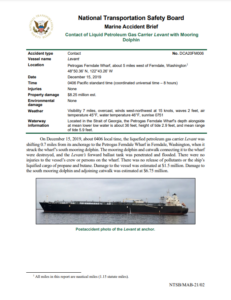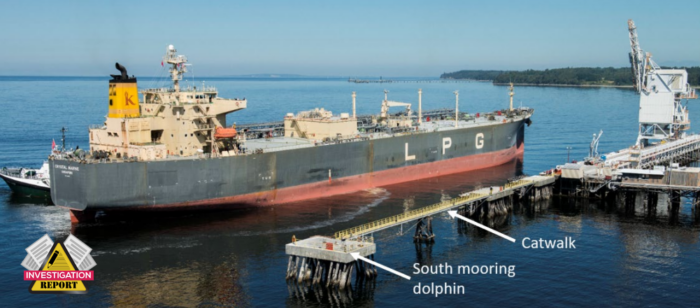The National Transportation Safety Board focuses on the importance of proper planning, reporting of an incident that took place in 2019, when an LPG carrier stuck a Washington State wharf, the NTSB cites poor bridge resource management by the pilot, captain, and bridge team, along with complacency that resulted in more than $8 million in damage to the wharf and ship.
The Incident
On December 15, 2019, about 0406 local time, the liquefied petroleum gas carrier Levant was shifting 0.7 milesfrom its anchorage to the Petrogas Ferndale Wharf in Ferndale, Washington, when it struck the wharf’s south mooring dolphin.
At 0350, the pilot informed Puget Sound vessel traffic service (VTS) that the Levant would shift from the anchorage to the Petrogas Wharf, and that they would be alongside in about 45 minutes.
At 0352 the chief officer reported the anchor was up, and, following that, the master told him that he could leave the bow and the fourth officer would remain for the mooring operation. The master needed the chief officer at the ship’s cargo manifold to ensure the vessel was properly aligned to receive a shore connection. Over the radio, the master instructed the fourth officer to prepare the mooring lines for the docking. The pilot issued his first helm and propulsion orders of dead slow ahead and starboard 30 degrees rudder at 0354, while the vessel was on a gyro heading of 058 degrees.
Following, the pilot ordered slow ahead, and following that, the pilot informed the master that the current was setting to the north-northwest along the shoreline at a velocity he calculated at 1.2 knots. At 0358, the Garth Foss was secured with a line on the port bow of the Levant.
At 0401, on an ordered course of 065 degrees and speed of 4.3 knots over the ground, the pilot ordered dead slow ahead.
The investigation report notes that
For about the next 2 minutes a conversation about non-navigational, non-operational matters took place between the master and pilot.
Following, the pilot ordered the rudder hard to port. The pilot recalled that, about this point, “something didn’t feel right,” so he briskly walked from inside the bridge out to the starboard bridge wing. The Levant’s bow was less than two ship lengths from the south mooring dolphin of the Petrogas Wharf, and the ship’s electronic chart display and information system (ECDIS) recorded the wind from the west at 15 knots. A few seconds after the hard-to-port helm order, the operator of the Garth Foss called the pilot on the Levant asking him for orders, to which the pilot replied to stand by.
On the bow, the mooring crew was preparing the mooring lines when a seaman alerted the bosun of the proximity to the Petrogas Wharf, who in turn alerted the fourth officer. The fourth officer said he saw the ship approaching the wharf “very fast,” and both he and the bosun went to a position where they could see the wharf and south mooring dolphin. The fourth officer radioed the master that there was a 40-meter distance to the mooring dolphin, and the master relayed this distance to the pilot.
After hearing this distance, the pilot ordered dead slow astern propulsion. The pilot asked for the distance to the wharf again, and he heard 10 meters as the reply over the radio. At 0406, the bosun announced over the radio the distance from the wharf was 5 meters before both he and the fourth officer moved further aft for personal safety. At that time, the heading of the Levant was 024 degrees with a speed of 4.3 knots, about 41 degrees off the dock alignment heading of 343 degrees.
[smlsubform prepend=”GET THE SAFETY4SEA IN YOUR INBOX!” showname=false emailtxt=”” emailholder=”Enter your email address” showsubmit=true submittxt=”Submit” jsthanks=false thankyou=”Thank you for subscribing to our mailing list”]
On the Petrogas Wharf, four operators at the cargo control room, standing by to resume loading operations on the Levant, saw the ship approach. One operator described the vessel’s approach as “extremely fast.” At 0406, the Levant struck the south mooring dolphin, and, a few seconds later, the pilot ordered full astern and both tugs to pull full away. Upon seeing the ship hit the south mooring dolphin, the operators and line handlers ran down the causeway to the shore. Witnesses on the wharf described seeing that the first point of contact was the portside bow section of the Levant hitting the southeast side of the south mooring dolphin, which was knocked down along with the catwalk connecting it to the wharf.
The Levant continued to slow but still made headway after striking the mooring dolphin until 0408, when it came to a brief stop before beginning to make sternway from the ship being in full astern propulsion with the tugs pulling full back.
After the contact with the mooring dolphin, the Levant crew discovered that an empty forward ballast tank was taking on water. A subsequent damage assessment found four hull breaches below the waterline in the Levant’s number one port ballast tank, and a crease approximately 40-60 inches long on the port bow. The estimated cost to repair the damage to the vessel was $1.5 million. The south mooring dolphin and adjoining catwalk at the Petrogas Wharf were completely destroyed; the estimated replacement cost was $6.75 million.
Immediate cause of the accident
The National Transportation Safety Board determines that the probable cause of the contact of the liquid petroleum gas carrier Levant with a mooring dolphin at the Petrogas Ferndale Wharf was the pilot’s approach with excessive speed and at too steep an angle, resulting from the pilot’s and bridge team’s poor bridge resource management.
The report highlights that
- There was not an effective exchange of information between the pilot and bridge team prior to getting under way regarding the pilot’s plan to bring the Levant to the Petrogas Wharf.
- The master and pilot conducted a master/pilot exchange before the Levant got under way from the Petrogas Wharf to the anchorage on the evening of December 14; however, that exchange was for an undocking maneuver, and the accident occurred during a docking evolution.
The master is ultimately responsible for the safety of the ship, which gives him the obligation to question and, if necessary, take over from the pilot in case he is in doubt of the pilot’s judgment,
… the report notes.
Concluding, you may learn more by clicking on the investigation report herebelow

































































